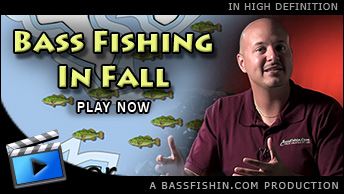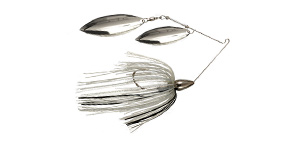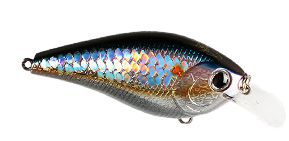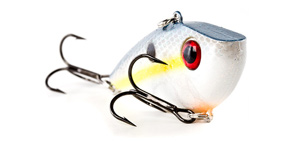



Fall Bass Fishing Strategies Video
When it comes to fall bass fishing, nothing is more important than knowing the fall bass migration. In this video, we detail the full fall migration cycle and explain why this crucial migration occurs and how you can benefit from a thorough understanding of these seasonal bass movements. We cover a lot of scientific theory and evidence and share with you valuable techniques and strategies to catch more fall bass.

If you're like me, cooling temperatures and the end of summer is a big dose of depression. For much of the US, the fall season is merely a warning of things to come, with brutally cold conditions just around the corner. But if you are one of the few lucky Americans who live South enough to avoid god-awful ice and snow, or even avoid winter altogether, south florida, then you know how different of meaning fall can mean to you as a bass fisherman.
So before we start, it is worth noting that many of the seasonal movements and strategies I'm going to discuss, may not be applicable to your part of the country. I will however attempt to cover some fall strategies in these very southern and warm climates. So lets get started.
To discuss the movements of bass during fall, you have to start with the summer-fall transition period, which on most lakes and rivers across the US begins sometime between mid-September and early-October. In summer, bass typically hang out in deeper water on the main lake or river, favoring the cooler water temps. While many bass do remain on shallow cover and in creeks, it is far more common to find larger numbers of bass on the main lake.
Now when fall starts encroaching on summer's long-standing weather patterns, and water temps begin to dip for the first time, a lot of bass quickly pickup on the change of season and start making their fall migrations, but just as many seem to ignore the temp drops and wait for further more concrete evidence that Fall is here to stick around. It is this very scenario, some bass making their migrations, and some bass still staying put, that can make bass tough to figure out and pattern. Many fish will be transient, and the ones that do stick around and are present for your summertime tactics are simply too few in number to provide any notable success.
Luckily, the summer to fall transition is short-lived in most cases. A couple weeks of tough fishing can give way to two-straight months of solid fishing. During this seasonal transition, mixing both summer and fall patterns will be the only way to recognize when the majority of bass have began the migration.
The fall bass season should be broken down into three parts, early-fall, mid-fall, and late-fall. In early fall, schools of baitfish, most notably shad, are of extreme importance to both anglers and bass. During summer, shad are primarily suspended in deeper water on the main lake or river. When early fall arrives however, they begin their migration in search of food to fatten up for the winter, just like bass do. But the shad's main target is plankton, and generally the greater abundance of plankton can be found in the upper ends of creeks in the fall. And we'll get into more on that later, but for now, understand that this movement of shad and bass have begun. But this movement is sort of a long-winded cycle that doesn't happen instantaneously. And just like how pre-spawn is the first part of the spring season, the first leg of the fall cycle is early fall.
As the bass retreat from their summer sanctuaries, they move to the mouths and lower-ends of creeks and tributaries. The bass become very scattered as they begin their migration, and this early on, they are not schooled up yet like we find them later on in the fall. Bass scatter in shallow water structure and cover found on main lake points, and on both shallow and deep flats in the lower thirds of creek arms. Though shallow water cover should be your primary target when fishing hard cover and structure, deep water flats that contain weedbeds can be prime areas because the shallower portions of the weedbed may begin dying off, and the bass will move to the outer, deeper weeds as they are the last to start dying. These deep edge weeds can be prime targets to find your greatest concentrations of fish in a confined area during the part of fall when bass are most scattered.
This is a time of year when bass are roaming a lot, and transient fish are often hard to pattern, as was the case with the summer-fall transition period. But luckily, early fall bass are feeding heavily and looking for hearty forage to feast on.
So we know the fish are scattered, roaming and towards the mouths of creeks. Our primary objective should be to seek out the most active fish up shallow, using lures that can cover a lot of water quickly. In early fall, it's all about covering water and presenting your bait to as much cover and structure as possible. The bass are looking for that hearty meal, so big lures that imitate baitfish such as shad are going to be your top choice. Big spinnerbaits with big double willow-leaf blades, shallow running crankbaits for laydowns, stumps, and rocks, deep running crankbaits for deep weed-edges on flats. Early fall is a fantastic time to swim a white jig as well. A white jig imitates a shad beautifully, and can offer a different look to bass who are accustomed to seeing the standard spinnerbaits and buzzbaits. A lipless crankbait can also produce, allowing you a little more versatility with depth compared to a lipped crankbait and it allows you to retrieve the bait quicker to cover more water.
Those shad that are going to be on the mouths of creeks and primary points, are going to be near the surface of the water, so keep in mind that bass that use to hang on the bottom in the summer, will most likely be suspended on cover, looking for those schools of shad near the top. Just because they are suspended doesn't mean they will be hard to catch, it just means you have to be cognizant not to work your bait near the bottom so much, since they aren't relating to the bottom this time of year.
Again, both shallow flats and deep flats with weeds are prime hotspots on the main lake, especially around the mouths of tributaries. Those flats offering isolated cover will far outproduce flats chock full of cover. Because of the scattered nature of bass at this time of year, isolated cover on a flat provides a higher percentage target to cast to, than a piece of cover surrounded by hundreds of other pieces of cover on a different flat. For these flats with isolated cover, fan casting a lipless crankbait, for instance, can be a great way to cover water quickly and expose those isolated pieces of cover.
Remember at the beginning of the video where I made mention that a lot of the seasonal movements and strategies I discuss aren't going to be applicable to some parts of the country? (FLASH SOUTH FLORIDA) Well, it's south Florida that is the outlier in this discussion. I said earlier that Fall is nearly a stepping-stone to winter... well South Florida doesn't even have a winter. I crack up everytime I see on a national weather report that people in Miami experienced an overnight low of 65, then it shows clips of people walking the streets with earmuffs and mittens. It simply doesn't get cold in South Florida and what happens to bass on northern lakes and rivers ceases to exist down there. In fact, while a lot of lakes up north are being drawn down, in other words the water authorities are bringing the lake levels down in anticipation to winter to kill off problematic weeds, the opposite is happening down in South Florida. Summer lake levels are generally low due to two reasons. The heat and the fact that water authorities keep them low to prevent flooding during the hurricane season. The cooler fall allows authorities to raise lake levels and more rain can bring lake levels often times much higher than they were in summer. And it is this scenario, that is the determining factor for the shift to fall fishing patterns. The rising water will push the baitfish into shallower weeds and grass. Unlike in mid to late fall when the shallow grass starts dying off and bass are moving to the deeper and more alive portions, south florida bass are moving further into the weeds.
Another notable difference between northern bass and south florida bass, is that the fall feeding frenzy up north is to prepare for a long and cold winter, where bass won't have the energy to roam for food. So they stock up as best they can in the fall, to hold them over during the winter months. But in Florida, it's a much different reason. That fall feeding frenzy is happening as preparation for the spawn. Since there is no real winter in South Florida, essentially the fall is a pre-spawn feeding rush. And the farther south you go in the country, in other words, the warmer the climate, the longer the spawn is. So in south florida, they get a much longer and sometimes frequent spawn through late November to even as late as March.
And I hope you have already come to the conclusion that when I speak of early fall, mid-fall, late-fall, and so on, that these parts of the season don't occur at the same time in all parts of the country. For instance, just because early fall may start in Wisconsin at the beginning of September, does not mean that early fall happens at the beginning of September for guys down in Alabama. It's all relative to where you are fishing. But nearly the entire country can apply the general fall strategies on their lake or river, with the exception of South Florida who is clearly the biggest outlier. And that's all I'm going to say about South Florida from here on out. Any more talk about South Florida during this season would best be left to a pre-spawn video, and that's exactly what we will do when that time comes.
The mid-fall is the real meat and potatoes of the fall bass fishing season. This is the part of fall that anglers refer to most when they speak of fishing in the fall. Very much of the mid-fall patterns are similar to the early-fall patterns, with exception of where the shad and bass are in relation to the creeks.
As we previously pointed out, early-fall brings shad and bass to shallow flats and cover around creek mouths and just inside the tributary arms. The mid-fall is the second leg of the fall migration cycle and it's important to understand not only what occurs, but why it occurs.
As water temperatures continue to drop into the low-60's and down into the upper-50's, mid-fall migrations begin. The primary point of focus should be the schools of baitfish. Again, shad is the big forage on many lakes and rivers, so these shad will be looking to make their move and the bass will follow. As mid-fall begins, the shad begin moving up the creeks, following the channel until they finally reach the backs of these tributaries. The reason they make this migration to the backs of creeks is simple, food. Shad feed on microscopic organisms called phytoplankton, which are too small to chew, so the shad actually filter the water absorbing phytoplankton as their main diet. And while these plankton don't swim around the lake like shad do, they do proliferate in certain areas more so than others in the fall season.
Phytoplankton survives by producing energy from captured sunlight. Phytoplankton is attracted to sunlight and through photosynthesis, they turn green because of a pigment within the organism called chlorophyll. In small numbers, you can't see phytoplankton in your bass lake, but if phytoplankton is really proliferating in a certain area, it gives the water a greenish tint. THAT'S THE PHYTOPLANKTON! If you see your water has a greenish tint, that should tell you that there is an abundance of phytoplankton in that area... that's the chlorophyll telling you, HEY! YOU GOT SOME REALLY NUTRIENT RICH WATER HERE! And shad love it! That is exactly what the shad are looking for to feed on.
So, we now know that the bass follow the shad, and the shad are moving. And we know shad are feeding heavily for winter just like the bass, so it stands to reason that they will seek out their food source too! And that leaves us to the backs of creeks. That's where you're most likely to find that green water. The green water is the phytoplankton, the start of the food chain in the bass' diet.
We've answered quite a bit so far as to why this migration occurs, but you might be wondering why there is more phyotoplankton in the backs of creeks than on the main lake. It's a good question that deserves some attention as a bass angler. As we mentioned before, phytoplankton derive their energy from sunlight. Without sunlight, photosynthesis does not occur and it dies. But phytoplankton needs something else to survive, they need three chemical nutrients, phosphate, nitrate and silicic acid.
Phosphates and nitrates are key ingredients to common inorganic fertilizers. Now we have all probably been to some sort of farm pond to fish and have seen a nasty greenish muck on top of the farm pond, commonly referred to as an algal bloom, which is simply an explosion of algae in the water. So to take this example, an algal bloom is a species or various species of phytoplankton together. So these farm ponds we often see with the green muck on top happen for one major reason, too much phosphate and nitrates in the water, two chemicals that phytoplankton's growth is linked too. Well it's easy to see that surface runoff from the farmer's land into his pond is causing a massive growth explosion of phytoplankton.
Now how does this example relate to the green water in the backs of creeks you might ask. Well, as it turns out, most of the surface runoff that occurs in lakes and rivers starts at the backs of creeks. Feeder streams are common in many creeks throughout the US and because the very backs of creeks have the smallest water to shoreline ratio, it stands to reason that surface runoff will bring far greater concentrations of nutrients into the surrounding waters. Again, inorganic fertilizers contain phosphate and nitrates, both the key ingredient to the proliferation of phytoplankton.
But too much phytoplankton isn't always a good thing. Of course, when you start seeing an algal bloom in a farm pond like our previous example, that's really bad, because when that much phytoplankton is one area, bacteria arrive to feed on the dead phytoplankton falling to the bottom of the water, and through this process of decomposition, dissolved oxygen levels are decreased, sometimes to the point of fish kills.
Now when I talk about how you should go find that green water, I certainly don't mean go find an algal bloom. Just a light greenish tint is good enough to tell you there is a good population of food for the shad in a particular area.
Let's say the lake you are fishing has tons of creeks, and many of the creeks have that nice green tint in the backs of them. How do you know which creek is better than the others? Well one of the things I look for is current. Current will always improve the mid-fall bite in the backs of the creeks. Why? Because current stirs up the water, and it generally means that there is some sort of feeder stream flowing into the creek. This feeder stream and current helps produce a higher dissolved oxygen content in the back of the creek, helping to cure any oxygen depletion that may occur due to decomposing phytoplankton.
As you can see, both the shad and phytoplankton play a major role in the fall migration into the backs of creeks. But let's now talk about techniques and presentation, and learn how to pinpoint the best bite at this time of the season.
Like I mentioned earlier, mid-fall techniques are quite similar to early-fall techniques, just that it's further up the creeks. The bass are still going to be very shallow, relating to schools of shad near the surface. When you think mid-fall, think flats with isolated cover. Flats in the creeks that are near a defined creek channel are gold, because the shad will move back and forth from the flats to the channel throughout the day. Creeks that are very narrow or small, may not have any flats, but rather just have a creek channel that skirts both shorelines. This can be a prime area as well because the creek acts as a funnel, helping the bass push the schools of shad into tighter pods.
One very good technique that a lot of anglers use to help locate bass in mid-fall is to motor all the way to the back of a creek to start fishing, and work your way out the creek until you find the aggressive fish. Sometimes the bass and shad have not made their way up to the very back yet, and this is a good tactic to use to help determine where the fish are in their migration.
Since bass aren't as scattered and suspended so much as they were in early-fall, you can now focus more attention on those isolated pieces of cover such as stumps, laydowns and bottom irregularities. When wood cover are the primary targets, square-billed shallow crankbaits are tough to beat. Stick with your fast-retrieve baits like square-billed and lipless cranks, spinnerbaits, and buzzbaits. Since bass are starting to group up more and more into the fall season, buzzbaits can be a great way to call some fish up top. Bang your buzzbait into the cover and fish it on the flats.
Just like early fall, big baits are going to be preferred, but as we approach late-fall and further cooling temperatures, those big baits are going to lose their appeal fast, so recognizing the end of the mid-fall period is paramount.
The final leg of the three-part fall cycle is late-fall. Generally late fall starts showing the onset of a cold winter, bringing water temps down in the low-50s and 40's. The late-fall period brings a reversal of the mid-fall migration pattern. The bass are now starting to move out of the creeks and back towards the main lake or river. The shad and bass are evacuating the shallow cover on the flats and retreating to the deep edges of the channels in preparation for winter.
While bass are still feeding heavily during this period, their feeding time frame is shortened, and now occurs more in short bursts during the day when the surface temps are warmest. This is why in late fall we find bass schooling quite heavily on shad in open water. Since the shad are now suspending offshore, their feeding takes place when the sun is directly overhead, bringing the shad to the surface where the schools of bass can bust them on top. The reason the shad feed at the surface at mid-day is because the phytoplankton rises in the water column to meet the sunlight. Remember, phytoplankton require sunlight for energy, so they seek it out by rising to the surface, and the shad follow suit.
So if you are looking for the easiest and most aggressive bite during late-fall, schooling bass may be your best choice. But don't count on too much action in the low-light hours, there isn't enough sunlight to pull the plankton and shad up to the surface. You're going to have to wait them out till the sun is overhead to see the schools come to life. As long as the water is generally above 50 degrees, topwaters like stickbaits, poppers, and sub-surface baits like spoons and fork-tailed smoke grubs on a 1/2 oz. jighead is most likely your best bet for schooling bass.
Now a lot places I frequently fish aren't well known for schooling bass busting shad on the surface. And some lakes and rivers are just that way. So unfortunately you're going to have to go to a more subtle and slow approach in deeper water for those pre-winter fish.
Late fall is a great time to target deep weed edges. The shallow vegetation is most certainly dying off at this time and what's still alive will be found in the deepest part of the weedbed. Creek channel edges at the mouths will also be prime targets as bass stage for their wintering locations. Remember, bass have moved to deeper water and feeding isn't necessarily a big item on their to-do list. They've fattened up for the most part in mid-fall, so you're going to have to force feed them with a tempting, finesse bait.
Hair jigs are an absolutely phenomenal late-fall lure. I work them around the deep edge of ledges and channels on outside bends on the lower part of creeks. Standard jigs with silicone or rubber skirt simply display too much action and movement for late-fall. You really need to be careful that you show the fish something, well, almost boring and lifeless, since that seems to be the widespread mood of everything that swims this time of year. Work the hair jig very slowly, to the point of exhaustion. Don't worry about covering water, because bass are really grouped up together in winter, often in packs of hundreds. Problem is, they are extremely hard to catch. But deadstick a bait in front of a couple and you might just get bit.
Late-fall is certainly the iffiest part of the fall cycle, because it's got a little of the winter doldrums in it. Focus on your deeper water on the main lake and river and just inside the creek arms. Finesse is the name of the game and subtle and boring lures catch the fish.
We've covered quite a bit in this video and I hope I've conveyed the importance of not only understanding these seasonal migrations, but utilizing them to help locate fish more effectively. Knowing what seasonal pattern the fish are in should always step one. Use these lessons as a guide and you'll quickly get tuned in to what's happening on your body of water.

- Review: Minn Kota vs. MotorGuide
- The Blog: Vintage Fishing Tackle Videos
- The Blog: Join Me In Standing Up Against...
- Review: Biography of Clay Dyer - Amazing!
- Review: Lazer Trokar Hooks: My Impressions
- Review: Suffer Eye Irritation From Boating?
- Video: SpaceNavigator For Geospatial Apps
- Video: The "Wiffle Spool" Trick
- Video: Setting Brake On Baitcasters
- Video: Preventing Twists On Spinning Reels
- The Blog: The Fishing Line Guide
- Video: The Geospatial Advantage
- Video: Baitcaster Backlash 'Thumb Trick'
- Store: Big Bass Zone
- Special: The BassFishin.Com Newsletter
- Video: How To Texas Rig A Bait










